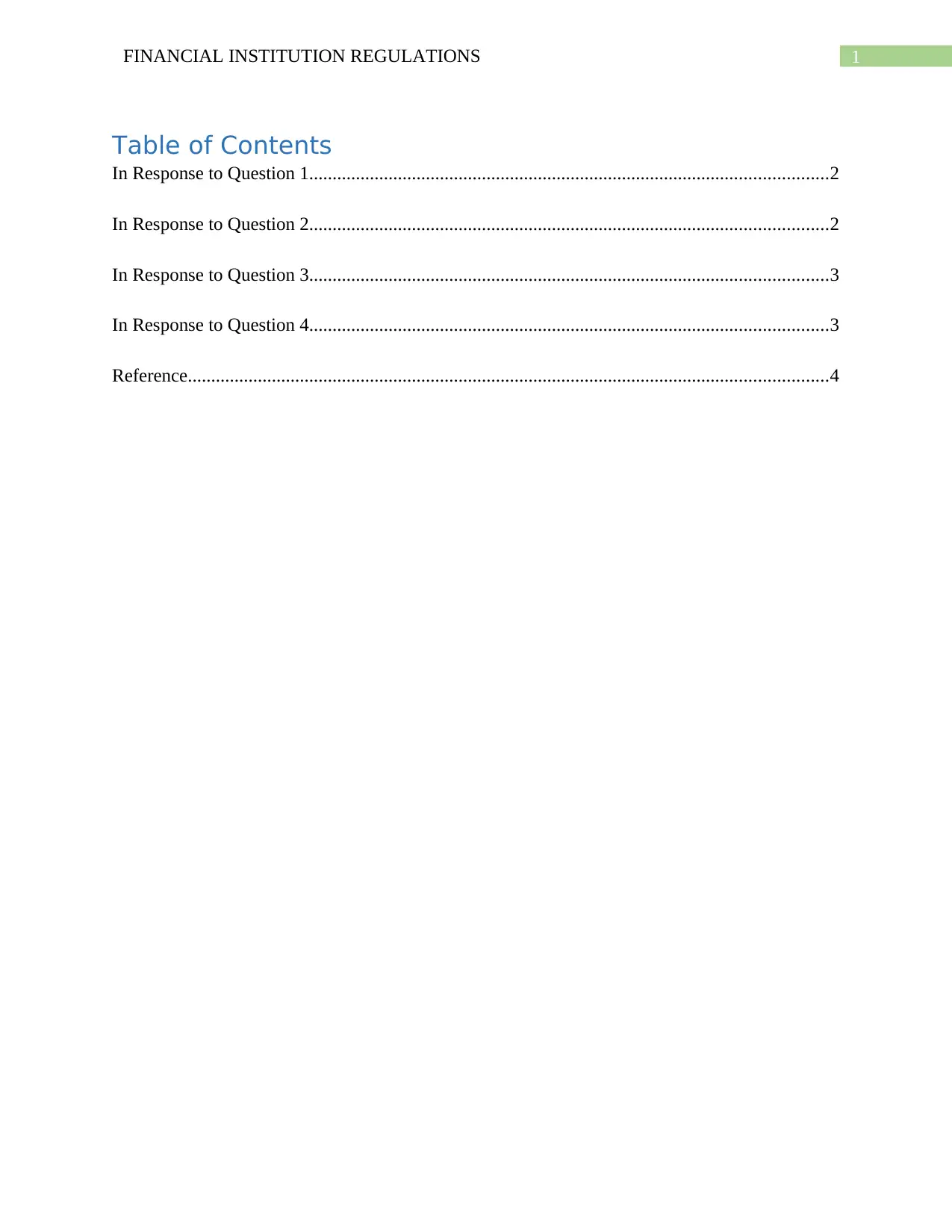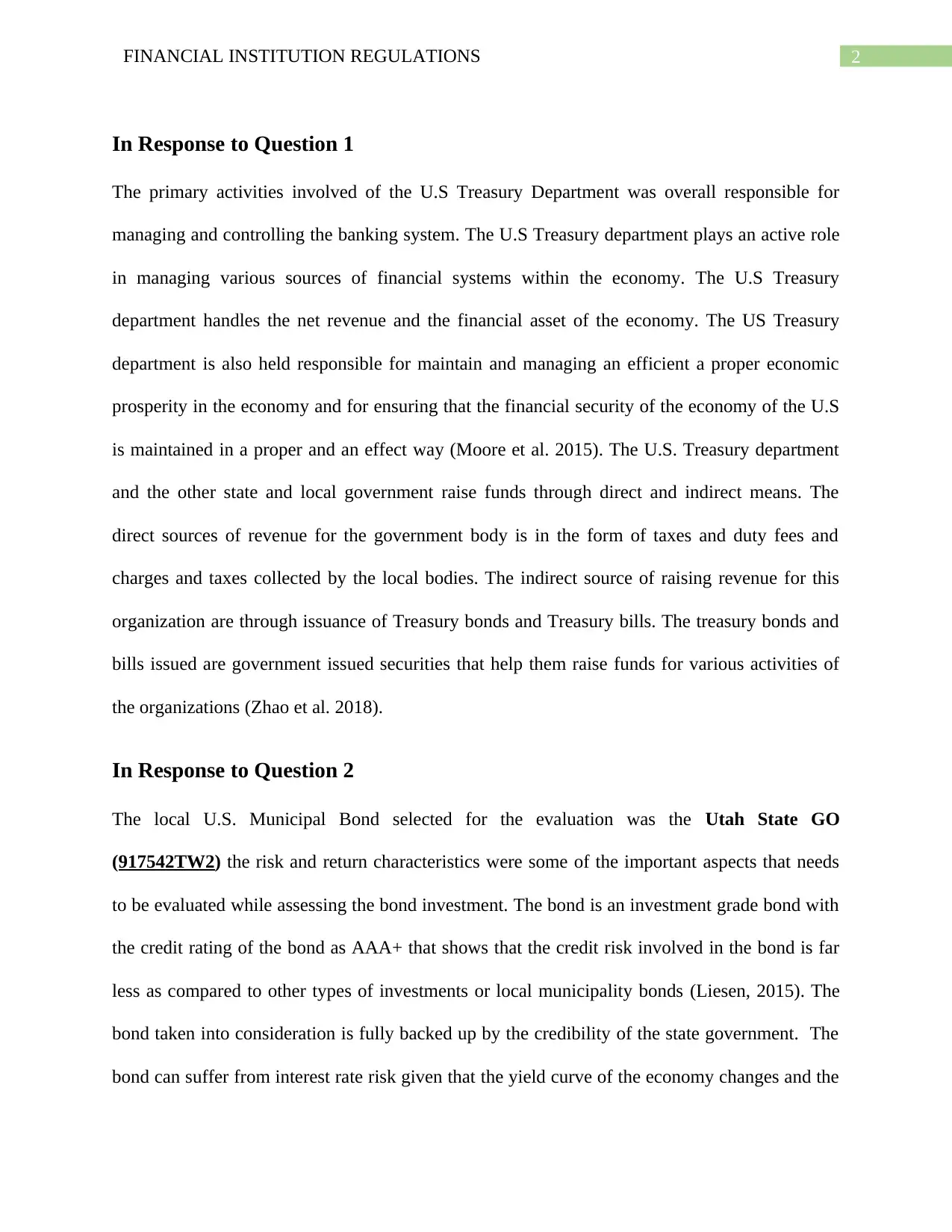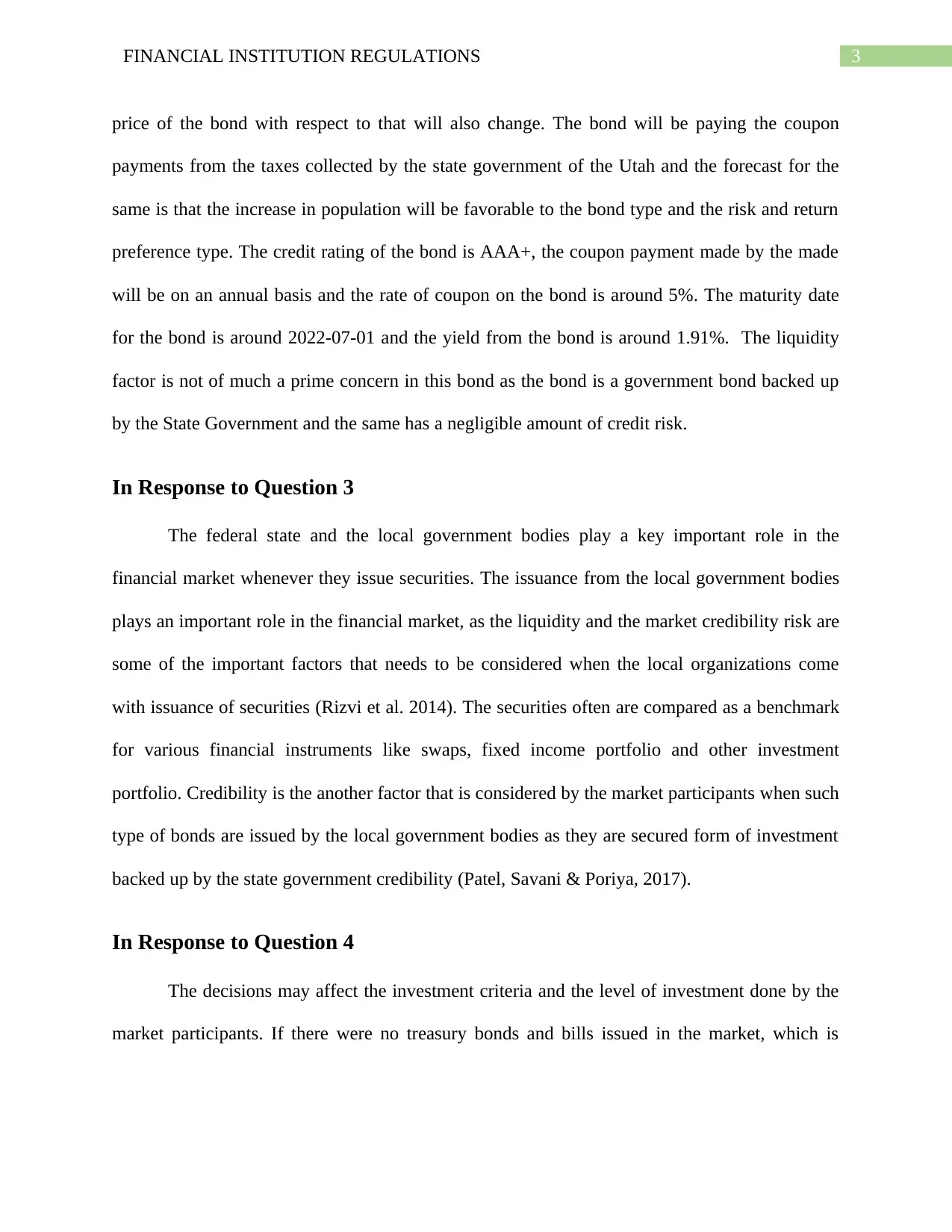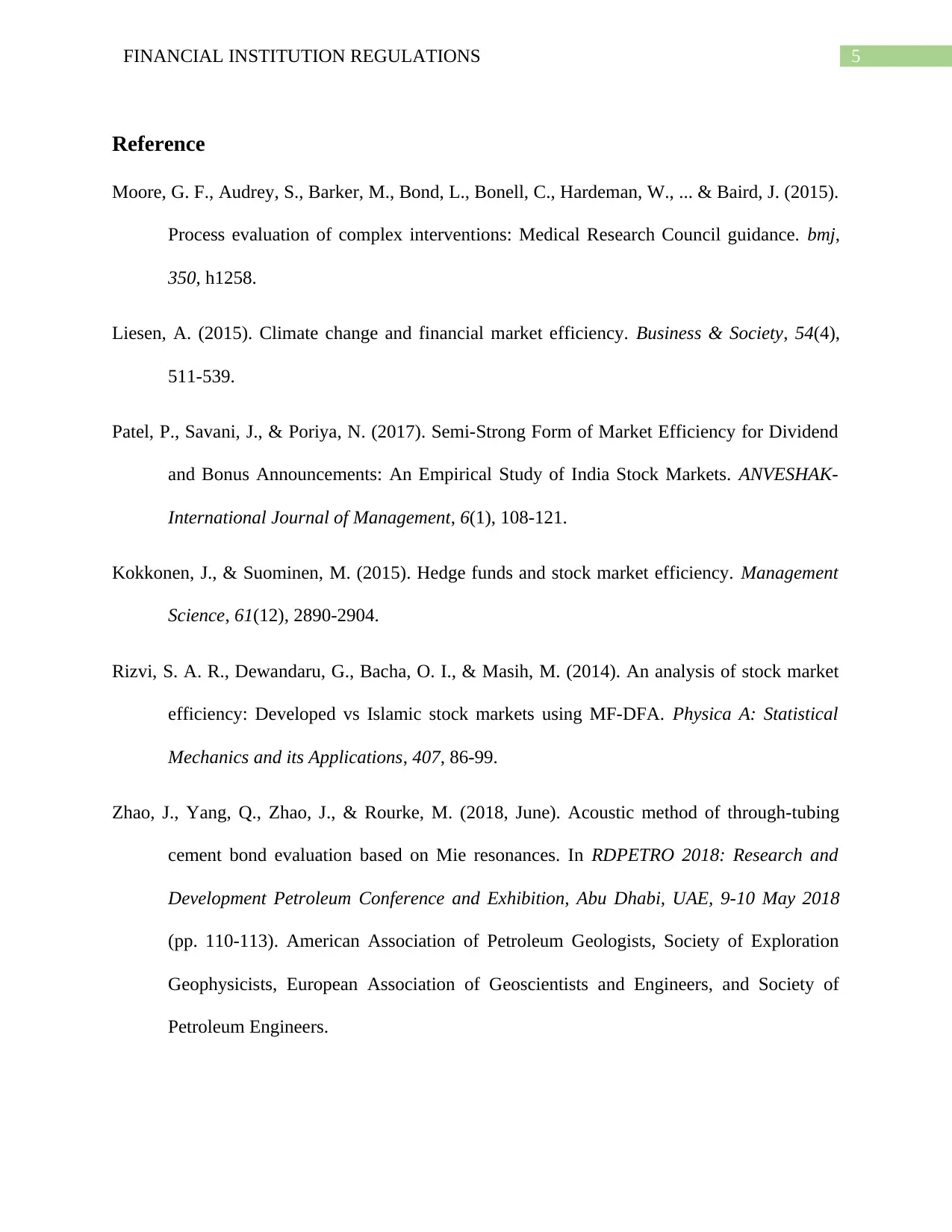Financial Institution Regulations: Role of US Treasury Department
VerifiedAdded on 2023/06/03
|7
|1072
|424
Report
AI Summary
This report delves into the financial institution regulations and the crucial role of the U.S. Treasury Department in managing the banking system and ensuring economic prosperity. It examines the Treasury's responsibilities in handling revenue, financial assets, and maintaining financial security, along with its methods of raising funds through taxes, duties, and the issuance of Treasury bonds and bills. The report also evaluates a specific U.S. Municipal Bond, Utah State GO (917542TW2), analyzing its risk and return characteristics, including credit rating, coupon payments, maturity date, and yield. Furthermore, it discusses the significance of federal, state, and local government bodies in the financial market, particularly concerning the issuance of securities and their impact on market credibility and liquidity. Finally, the report considers the potential effects on investment decisions if Treasury bonds and bills, considered risk-free assets, were not available in the market.

Running head: FINANCE
Finance
Name of the Student:
Name of the University:
Author’s Note:
Finance
Name of the Student:
Name of the University:
Author’s Note:
Paraphrase This Document
Need a fresh take? Get an instant paraphrase of this document with our AI Paraphraser

1FINANCIAL INSTITUTION REGULATIONS
Table of Contents
In Response to Question 1...............................................................................................................2
In Response to Question 2...............................................................................................................2
In Response to Question 3...............................................................................................................3
In Response to Question 4...............................................................................................................3
Reference.........................................................................................................................................4
Table of Contents
In Response to Question 1...............................................................................................................2
In Response to Question 2...............................................................................................................2
In Response to Question 3...............................................................................................................3
In Response to Question 4...............................................................................................................3
Reference.........................................................................................................................................4

2FINANCIAL INSTITUTION REGULATIONS
In Response to Question 1
The primary activities involved of the U.S Treasury Department was overall responsible for
managing and controlling the banking system. The U.S Treasury department plays an active role
in managing various sources of financial systems within the economy. The U.S Treasury
department handles the net revenue and the financial asset of the economy. The US Treasury
department is also held responsible for maintain and managing an efficient a proper economic
prosperity in the economy and for ensuring that the financial security of the economy of the U.S
is maintained in a proper and an effect way (Moore et al. 2015). The U.S. Treasury department
and the other state and local government raise funds through direct and indirect means. The
direct sources of revenue for the government body is in the form of taxes and duty fees and
charges and taxes collected by the local bodies. The indirect source of raising revenue for this
organization are through issuance of Treasury bonds and Treasury bills. The treasury bonds and
bills issued are government issued securities that help them raise funds for various activities of
the organizations (Zhao et al. 2018).
In Response to Question 2
The local U.S. Municipal Bond selected for the evaluation was the Utah State GO
(917542TW2) the risk and return characteristics were some of the important aspects that needs
to be evaluated while assessing the bond investment. The bond is an investment grade bond with
the credit rating of the bond as AAA+ that shows that the credit risk involved in the bond is far
less as compared to other types of investments or local municipality bonds (Liesen, 2015). The
bond taken into consideration is fully backed up by the credibility of the state government. The
bond can suffer from interest rate risk given that the yield curve of the economy changes and the
In Response to Question 1
The primary activities involved of the U.S Treasury Department was overall responsible for
managing and controlling the banking system. The U.S Treasury department plays an active role
in managing various sources of financial systems within the economy. The U.S Treasury
department handles the net revenue and the financial asset of the economy. The US Treasury
department is also held responsible for maintain and managing an efficient a proper economic
prosperity in the economy and for ensuring that the financial security of the economy of the U.S
is maintained in a proper and an effect way (Moore et al. 2015). The U.S. Treasury department
and the other state and local government raise funds through direct and indirect means. The
direct sources of revenue for the government body is in the form of taxes and duty fees and
charges and taxes collected by the local bodies. The indirect source of raising revenue for this
organization are through issuance of Treasury bonds and Treasury bills. The treasury bonds and
bills issued are government issued securities that help them raise funds for various activities of
the organizations (Zhao et al. 2018).
In Response to Question 2
The local U.S. Municipal Bond selected for the evaluation was the Utah State GO
(917542TW2) the risk and return characteristics were some of the important aspects that needs
to be evaluated while assessing the bond investment. The bond is an investment grade bond with
the credit rating of the bond as AAA+ that shows that the credit risk involved in the bond is far
less as compared to other types of investments or local municipality bonds (Liesen, 2015). The
bond taken into consideration is fully backed up by the credibility of the state government. The
bond can suffer from interest rate risk given that the yield curve of the economy changes and the
⊘ This is a preview!⊘
Do you want full access?
Subscribe today to unlock all pages.

Trusted by 1+ million students worldwide

3FINANCIAL INSTITUTION REGULATIONS
price of the bond with respect to that will also change. The bond will be paying the coupon
payments from the taxes collected by the state government of the Utah and the forecast for the
same is that the increase in population will be favorable to the bond type and the risk and return
preference type. The credit rating of the bond is AAA+, the coupon payment made by the made
will be on an annual basis and the rate of coupon on the bond is around 5%. The maturity date
for the bond is around 2022-07-01 and the yield from the bond is around 1.91%. The liquidity
factor is not of much a prime concern in this bond as the bond is a government bond backed up
by the State Government and the same has a negligible amount of credit risk.
In Response to Question 3
The federal state and the local government bodies play a key important role in the
financial market whenever they issue securities. The issuance from the local government bodies
plays an important role in the financial market, as the liquidity and the market credibility risk are
some of the important factors that needs to be considered when the local organizations come
with issuance of securities (Rizvi et al. 2014). The securities often are compared as a benchmark
for various financial instruments like swaps, fixed income portfolio and other investment
portfolio. Credibility is the another factor that is considered by the market participants when such
type of bonds are issued by the local government bodies as they are secured form of investment
backed up by the state government credibility (Patel, Savani & Poriya, 2017).
In Response to Question 4
The decisions may affect the investment criteria and the level of investment done by the
market participants. If there were no treasury bonds and bills issued in the market, which is
price of the bond with respect to that will also change. The bond will be paying the coupon
payments from the taxes collected by the state government of the Utah and the forecast for the
same is that the increase in population will be favorable to the bond type and the risk and return
preference type. The credit rating of the bond is AAA+, the coupon payment made by the made
will be on an annual basis and the rate of coupon on the bond is around 5%. The maturity date
for the bond is around 2022-07-01 and the yield from the bond is around 1.91%. The liquidity
factor is not of much a prime concern in this bond as the bond is a government bond backed up
by the State Government and the same has a negligible amount of credit risk.
In Response to Question 3
The federal state and the local government bodies play a key important role in the
financial market whenever they issue securities. The issuance from the local government bodies
plays an important role in the financial market, as the liquidity and the market credibility risk are
some of the important factors that needs to be considered when the local organizations come
with issuance of securities (Rizvi et al. 2014). The securities often are compared as a benchmark
for various financial instruments like swaps, fixed income portfolio and other investment
portfolio. Credibility is the another factor that is considered by the market participants when such
type of bonds are issued by the local government bodies as they are secured form of investment
backed up by the state government credibility (Patel, Savani & Poriya, 2017).
In Response to Question 4
The decisions may affect the investment criteria and the level of investment done by the
market participants. If there were no treasury bonds and bills issued in the market, which is
Paraphrase This Document
Need a fresh take? Get an instant paraphrase of this document with our AI Paraphraser

4FINANCIAL INSTITUTION REGULATIONS
treated as a risk free asset in the market, then the pricing and the valuation of other risky bond in
this scenario will be difficult (Kokkonen & Suominen, 2015).
treated as a risk free asset in the market, then the pricing and the valuation of other risky bond in
this scenario will be difficult (Kokkonen & Suominen, 2015).

5FINANCIAL INSTITUTION REGULATIONS
Reference
Moore, G. F., Audrey, S., Barker, M., Bond, L., Bonell, C., Hardeman, W., ... & Baird, J. (2015).
Process evaluation of complex interventions: Medical Research Council guidance. bmj,
350, h1258.
Liesen, A. (2015). Climate change and financial market efficiency. Business & Society, 54(4),
511-539.
Patel, P., Savani, J., & Poriya, N. (2017). Semi-Strong Form of Market Efficiency for Dividend
and Bonus Announcements: An Empirical Study of India Stock Markets. ANVESHAK-
International Journal of Management, 6(1), 108-121.
Kokkonen, J., & Suominen, M. (2015). Hedge funds and stock market efficiency. Management
Science, 61(12), 2890-2904.
Rizvi, S. A. R., Dewandaru, G., Bacha, O. I., & Masih, M. (2014). An analysis of stock market
efficiency: Developed vs Islamic stock markets using MF-DFA. Physica A: Statistical
Mechanics and its Applications, 407, 86-99.
Zhao, J., Yang, Q., Zhao, J., & Rourke, M. (2018, June). Acoustic method of through-tubing
cement bond evaluation based on Mie resonances. In RDPETRO 2018: Research and
Development Petroleum Conference and Exhibition, Abu Dhabi, UAE, 9-10 May 2018
(pp. 110-113). American Association of Petroleum Geologists, Society of Exploration
Geophysicists, European Association of Geoscientists and Engineers, and Society of
Petroleum Engineers.
Reference
Moore, G. F., Audrey, S., Barker, M., Bond, L., Bonell, C., Hardeman, W., ... & Baird, J. (2015).
Process evaluation of complex interventions: Medical Research Council guidance. bmj,
350, h1258.
Liesen, A. (2015). Climate change and financial market efficiency. Business & Society, 54(4),
511-539.
Patel, P., Savani, J., & Poriya, N. (2017). Semi-Strong Form of Market Efficiency for Dividend
and Bonus Announcements: An Empirical Study of India Stock Markets. ANVESHAK-
International Journal of Management, 6(1), 108-121.
Kokkonen, J., & Suominen, M. (2015). Hedge funds and stock market efficiency. Management
Science, 61(12), 2890-2904.
Rizvi, S. A. R., Dewandaru, G., Bacha, O. I., & Masih, M. (2014). An analysis of stock market
efficiency: Developed vs Islamic stock markets using MF-DFA. Physica A: Statistical
Mechanics and its Applications, 407, 86-99.
Zhao, J., Yang, Q., Zhao, J., & Rourke, M. (2018, June). Acoustic method of through-tubing
cement bond evaluation based on Mie resonances. In RDPETRO 2018: Research and
Development Petroleum Conference and Exhibition, Abu Dhabi, UAE, 9-10 May 2018
(pp. 110-113). American Association of Petroleum Geologists, Society of Exploration
Geophysicists, European Association of Geoscientists and Engineers, and Society of
Petroleum Engineers.
⊘ This is a preview!⊘
Do you want full access?
Subscribe today to unlock all pages.

Trusted by 1+ million students worldwide

6FINANCIAL INSTITUTION REGULATIONS
1 out of 7
Related Documents
Your All-in-One AI-Powered Toolkit for Academic Success.
+13062052269
info@desklib.com
Available 24*7 on WhatsApp / Email
![[object Object]](/_next/static/media/star-bottom.7253800d.svg)
Unlock your academic potential
Copyright © 2020–2025 A2Z Services. All Rights Reserved. Developed and managed by ZUCOL.





